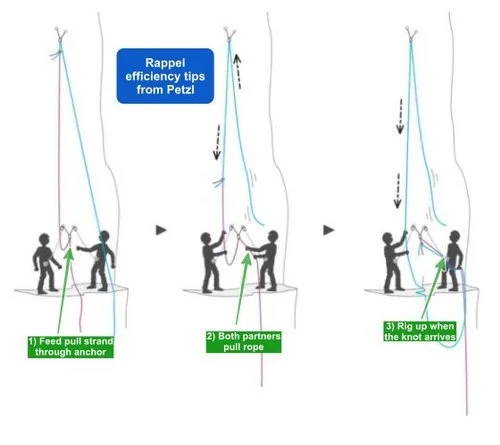Rappel efficiency tips from Petzl
When doing multipitch rappels, you can save a surprising amount of time by implementing a few small but significant efficiency steps. This great diagram from Petzl shows a few of them. Let's have a closer look.
The two climbers are doing a multipitch double rope rappel.
The knot is on the left side of the anchor, so they are pulling the purple rope.
LEFT: The end of the purple rope is threaded through the bottom anchor before they start pulling. (It's usually good practice to have a knot(s) in the end of at least one strand, that’s not shown here.)
MIDDLE: While the left side climber is pulling down, the right side climber is pulling the rope through the anchor. If it's steep, as in the diagram, the rope might simply feed down the cliff all by itself. That's great, no need to throw it at all. If it's not steep, the climber on the right could be stacking the rope, and preparing the end to throw. Here's a longer article on getting your ropes down the cliff.
RIGHT: As soon as the knot gets to the lower anchor, the right side climber can start rigging the rappel, while the left climber continues to pull down the blue rope. If the rope is cooperating, the blue rope will fall through the upper anchor, past the climbers, and then down to the next station or the ground.
Not shown: if the team pre-rigs the rappel, you only need the one knot in the end of the purple rope to safeguard the first person. You don't need a knot in the blue rope. This is because the second person down has the rope essentially locked off at their rappel device. If the first person down were to lose control of the rappel and slide down to the stopper knot in the end of the purple rope, that one knot would stop their slide. This is a big timesaver, because you don't have to pull up the blue rope after it falls, tie, a stopper knot in the the end, and then toss it down again.
For a longer explanation how this works, check out this detailed article on the pre-rigged rappel.


